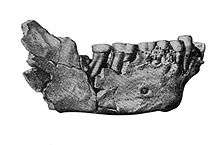Ehringsdorf skull

The Ehringsdorf skull was the fragments of a Neanderthal skull disinterred from a deposit of limestone at the Ehringsdorf quarries along the Ilm River, roughly 2.4 km from Weimar, Germany.[1] The deposits in which this skull were found included elephant, rhinoceros, horse, and bovid fossil remains and came from the travertines belonging to the second half of the last (Eemian) interglacial period. The estimated age of the remains are 150,000–120,000 years. It is commonly believed that the Ehringsdorf skull is a representation of early Neanderthal due to the size of the brownrides, the long and low braincase, and the strong lower jaw lacking a chin.[2]
In 1928, German anthropologist Franz Weidenreich published a monograph on the subject, titled Der Schädelfund von Weimar-Ehringsdorf,[3] where he described it as the skull-cap of an adult female. He suggested that the frontal area of the remains showed evidence of being struck, which led to the conclusion that the subject was murdered. In addition, he determined that the lack of a cranial base meant the skull had been opened for the purpose of extracting the brain. However, the remains were so fragmentary that little attention was paid to this opinion.[2]
The parts of this skull (discovered between 1908 and 1925) were found in the same stone bed that two specimen had previously been excavated. Based on the fusing of the skull and small muscular traces on the bones, Weidenreich believed the remains to be of a female of around 20–30 years old. The skull, like the ones found before it, showed distinct Lower Palaeolithic attributes. However, there were certain attributes that were similar to Upper Palaeolithic Cro-Magnon types, particularly in the frontal and medial vaulting.
The skull had some abnormalities, mainly that the left portion bulged out more than the right. Weidenreich believes this happened post-mortem, in the layer in which the piece was found. Another interesting factor is how the thickness of the skull varies. The Ehringsdorf endo-exocranial different is 4.6, which is remarkably low for the average Neanderthal man; however, the height of the skull is higher when compared. The incomplete region has no pronounced turning in of the temporal lobe, which corroborated Weidenreich's opinion that the skull was not of the Lower Palaeolithic type.
It is believed that the brain of the Ehringsdorf skull was eaten by cannibals that were rampant throughout Europe at the time. It was found with a thin layer of ashes, charcoal, and broken bones. It is hypothesized that the cannibals created a fire to get rid of any remains before they were discovered.
Scottish anthropologist Arthur Keith made a study of the skull in 1931, concluding that it belonged to an individual less than 20 years old.[4] Although classed as an early Neanderthal type, the skull bears some features found in the species Homo sapiens. In particular, it has a rounded occipital bone.[2]
Measurements
- Greatest Length: 196 mm
- Greatest Breadth: 145 mm
- Cephalic Index: 74
- Inside Length: 171 mm
- Inside Breadth: 134.5 mm
- L.H. index: 61.7
- Br.H. index: 83.4
- Calotte Height over the Glabello-inion line: 96 mm
- Glabello-inion Length: 192 mm
- Calvarial height Index: 50
- Positional Index of the Bregma: 29.9
- Bregma Angle: 56'
- Transverse Fronto-Parietal Index: 77.9
- Glabella Cerebral Index: 38.6
- Inter-orbital Index: 24.6
- Frontal Angel: 79'
References
- ↑ Phenice, T. W.; Sauer, Norman J. (1972). Hominid fossils: an illustrated key (2nd ed.). W. C. Brown Co. p. 55. ISBN 0-697-07552-4.
- 1 2 3 Washburn, Sherwood L. (2004) [1961]. Social Life of Early Man. Routledge Library Editions: Anthropology and Ethnography (Reprinted ed.). Psychology Press. pp. 128–131. ISBN 0-415-33041-6.
- ↑ Weidenreich, F. (1928). Der Schädelfund von Weimar-Ehringsdorf (in German). Jena, Germany: Fischer-Verlag.
- ↑ Keith, Arthur (1994). The Antiquity of Man. Anmol Publications. pp. 325–337. ISBN 81-7041-977-8. Retrieved 2011-04-26.